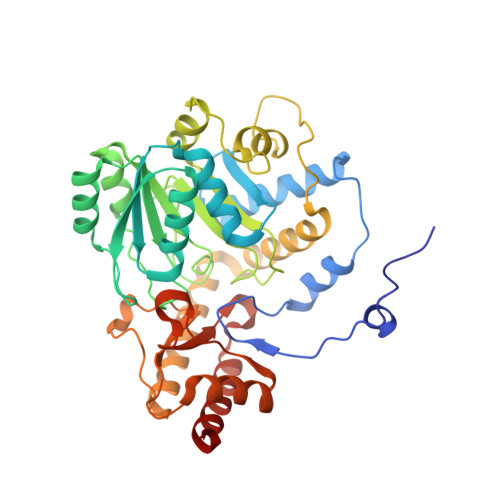The Consensus-Based Approach for Gene/Enzyme Replacement Therapies and Crystallization Strategies: The Case of Human Alanine:Glyoxylate Aminotransferase.
Mesa-Torres, N., Yunta, C., Fabelo-Rosa, I., Gonzalez-Rubio, J.M., Sanchez-Ruiz, J.M., Salido, E., Albert, A., Pey, A.L.(2014) Biochem J 462: 453
- PubMed: 24957194
- DOI: https://doi.org/10.1042/BJ20140250
- Primary Citation of Related Structures:
4CBR, 4CBS - PubMed Abstract:
Protein stability is a fundamental issue in biomedical and biotechnological applications of proteins. Among these applications, gene- and enzyme-replacement strategies are promising approaches to treat inherited diseases that may benefit from protein engineering techniques, even though these beneficial effects have been largely unexplored. In the present study we apply a sequence-alignment statistics procedure (consensus-based approach) to improve the activity and stability of the human AGT (alanine-glyoxylate aminotransferase) protein, an enzyme which causes PH1 (primary hyperoxaluria type I) upon mutation. By combining only five consensus mutations, we obtain a variant (AGT-RHEAM) with largely enhanced in vitro thermal and kinetic stability, increased activity, and with no side effects on foldability and peroxisomal targeting in mammalian cells. The structure of AGT-RHEAM reveals changes at the dimer interface and improved electrostatic interactions responsible for increased kinetic stability. Consensus-based variants maintained the overall protein fold, crystallized more easily and improved the expression as soluble proteins in two different systems [AGT and CIPK24 (CBL-interacting serine/threonine-protein kinase) SOS2 (salt-overly-sensitive 2)]. Thus the consensus-based approach also emerges as a simple and generic strategy to increase the crystallization success for hard-to-get protein targets as well as to enhance protein stability and function for biomedical applications.
- *Department of Physical Chemistry, Faculty of Sciences, University of Granada, Av/Fuentenueva s/n, 18071 Granada, Spain.
Organizational Affiliation:

















